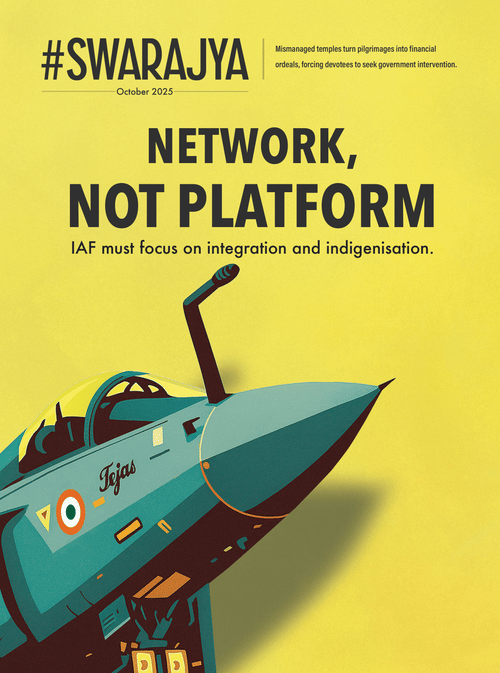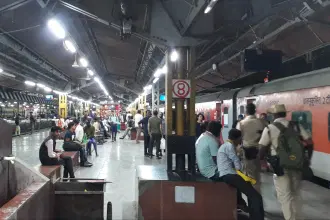Books
Whispers Of 'Jungle Raj': How Bihar's Lost Decades Still Haunt Its Progress
Mohini
Oct 27, 2025, 01:57 PM | Updated 02:04 PM IST
Save & read from anywhere!
Bookmark stories for easy access on any device or the Swarajya app.


Broken Promises: Caste, Crime and Politics in Bihar (2024). Mrityunjay Sharma. Westland Non-Fiction. Pages: 348. Price: Rs 389.
As Bihar stands on the precipice of another electoral crucible, awaiting the chance to shape its 18th legislative assembly, one cannot help but wonder if the infamous ghosts of the 1990s, echoing calls of "Jungle Raj", still haunt the corridors of Patna's secretariat.
The final voter list, freshly minted after a controversial Special Intensive Revision, will soon determine who gets to write Bihar's next chapter. But to understand where Bihar is heading, we must first excavate where it has been.
Mrityunjay Sharma's Broken Promises serves as the perfect archaeological tool for this excavation, providing a forensic examination of the fifteen years (1990-2005) that transformed India's second-most populous state from a land of potential into what the author calls a mini-Somalia in the heart of India.
Divided into seven parts, the book begins with the rise of Lalu Prasad Yadav as a "star" and culminates with a curious approach towards the ascent of "enigma" Nitish Kumar while examining the questions of caste, crime, corruption, and more in between.
A sophisticated attempt has been made by Sharma to connect the events of the state with the larger play of politics unfolding at the Centre, all while specifically following the tics and tricks of the erstwhile CM of Bihar, Mr Lalu Prasad Yadav, as the architect of change and chaos.
"Mayee hum mukhyamantri ban gaynee"
The rise of Lalu Prasad can be set against the existing socio-political setup of Bihar. Sharma notes that in Lalu's native village, Phulwaria, the domination of upper-caste households was evident, with about 80 per cent of the land belonging to them despite constituting only 10 per cent of the population.
This "hidden apartheid" wasn't an anomaly but the template across Bihar, where "massive inequalities caused by this landholding pattern had resulted in a power structure dominated by the upper castes over the years" (p. 8).
On entering B. N. College, Patna, a hotbed of university politics, Sharma comments that Lalu turned towards the Socialist party, not out of any deep concern for the ideological aspects of socialism or Lohia's philosophy, but rather because it was considered the "natural home for Bihar's backward caste" (p. 3).
With his gifted oratory, penchant for drama, and youthful energy that shone during JP's Sampoorna Kranti Movement, Lalu used "vernacularisation" as a tool of political ascendancy, quickly made his own mark (strengthened by the fated demise of Congress by the 80s), and emerged as the CM of Bihar in the aftermath of the 1990 Assembly Elections.
Lalu's hilarious exchange with his mother after the declaration of his chief ministership has been documented by Sharma:
"Mayee hum mukhyamantri ban gaynee (Mother, I have become the chief minister)."
"Achcha thik ba, jaaye de, lekin tohra sarkaari naukri naa nu milal (That's fine, but you still couldn't secure a government job)."
The author demonstrates how Lalu's early months actually showed genuine promise: improved law and order praised by Union Home Minister Mufti Mohammad Sayeed, successful handling of communal tensions that had previously torn Bihar apart, and a crusade against corruption that saw 400 officials suspended in just three months.
The tragedy, Sharma suggests, wasn't that Lalu lacked administrative capacity, but that he consciously chose electoral gains over progress.
The Politics of Performance
Sharma brilliantly illustrates how Lalu's genius lay not in governance but in understanding the psychology of the oppressed. From his very first day in office, Lalu understood that politics was a form of theatre. His decision to take the oath at Gandhi Maidan rather than Raj Bhavan, his bicycle rides to the secretariat, and his Janta Darbar sessions weren't mere publicity stunts but carefully crafted attempts at a politics of performance.
When he "publicly chastised senior officers, drawing cheers and applause from the public, who saw babus as the biggest perpetrators of corruption and injustice" (p. 7), he was simultaneously demonstrating his authority and channelling popular frustration.
The image of him sitting "in the middle of a busy road in Patna with a stick in hand, passing instructions to an administration in a tizzy" perfectly captures his understanding that visibility was the uncompromisable currency for credibility.
However, what began as an earnest revolt against upper-caste domination, Lalu promising "no atrocities, no excesses, no corruption and no dishonesty henceforth" from Gandhi Maidan (p. 4), quickly degenerated into mere electoral gimmicks.
Social justice rhetoric, based on Lalu's motto of "Vikas nahi, sammaan chahiye" (not development, but dignity), justified a form of government where governance was missing. When questioned on dilapidated roads, Lalu quipped, "If roads are built, the upper castes will benefit because they own the vehicles, not the poor" (p. 13).
The most deprived of the lot, who had also been the most optimistic with Lalu's rise, were in for a truckload of theatrics and disappointment. Despite fiery rhetoric about empowerment and justice, the most backward communities, like SCs, saw little genuine improvement. Their calls for land and tenancy reforms were stifled, largely to avoid alienating powerful OBC groups who had grown prosperous and protective of their gains.
Lalu's politics, for all its symbolic power, remained trapped in a zero-sum logic where one group's dignity required another's degradation. This approach, while electorally successful, ultimately impoverished the entire state: materially, morally, and politically.
The Trifecta of Change: Mandal, Kamandal, and the Fall of the National Front
The real turning point for Lalu came with V.P. Singh's decision to implement the Mandal Commission recommendations in August 1990. However, rather than following Karpoori Thakur's Bihar formula, which included separate quotas for Extremely Backward Castes and exclusions for higher-income earners, Singh clubbed the backward castes in a bid to raise a "dedicated caste grouping…of committed party cadre" and "blunt the BJP's Hindu vote consolidation" (p. 17).
Even in Bihar, unlike Karpoori Thakur, who had "a conciliatory approach", Lalu "used Mandal as a tool of political messaging rather than being concerned about its actual capacity for empowering backward castes", as evident in his indifference to implementing central and state schemes for socio-economic empowerment of marginalised castes (p. 20). The state machinery's response was equally appalling, with almost a dozen upper-caste youth killed by police repression in Anti-Mandal protests (p. 19).
In response to Mandal, Advani launched the Rath Yatra to consolidate the Hindu voter base, which reached a dramatic climax in Bihar, where the confrontation between Mandal and Kamandal became literal. Lalu's decision to arrest Advani at Samastipur, acting on his earlier warning, "I have had the milk of my mother as well as buffaloes. I will show you when you are in Bihar" (p. 25), represented the clear political cleavages.
Advani's arrest triggered the collapse of the National Front government, as the BJP withdrew its support. As Sharma observes, the two primary political winners to emerge from this episode were the BJP and Lalu. The BJP nearly doubled its vote share in the 1991 general elections, capitalising on the charged political climate. Meanwhile, Lalu's decisive action in detaining Advani propelled him to the forefront of anti-saffron politics.
Caste Wars in Bihar: Hell in the Heartland
Bihar's bloody decade from 1990 to 2001 was marked by a vicious cycle of retributive caste violence between landlord armies and Naxalite groups. In these eleven years alone, there were nearly sixty documented massacres, with about 571 people losing their lives in carnages that stunned the nation and earned the state its infamous reputation.
Sharma describes how private militias like the Ranvir Sena, representing upper-caste Bhumihars, and left-wing outfits like the Maoist Communist Central, largely staffed by Yadavs, committed acts of savagery that targeted entire communities, and even sleeping children were caught in the crossfire in their personal ideological quests.
Sharma recalls the Laxmanpur Bathe atrocity of 1997 with gut-wrenching details: "Two-year-old Sumitra, sleeping curled next to her mother, was shot in the abdomen. Her brother, five-year-old Arvind, had a bullet hole in his head" (p. 195). Such stories, unfortunately, were not rarities but casual occurrences.
The expected protectors, the police, were frequently either missing at critical moments or, worse, in open collusion with perpetrators, as seen in Ekwari, where the police forced open doors for the Ranvir Sena to enter and then watched as villagers were massacred and an eight-month pregnant woman raped (p. 153).
Communities learnt that in a state where sixteen people were being killed, looted, or kidnapped every hour, the best the police could offer was a "skeleton service" (p 154).
The political response was tragically inadequate and, unfortunately, electorally motivated. In the aftermath of the massacre at Senari village in Jehanabad district in 1999, where 34 Bhumihar men were forcibly dragged out of their homes and slaughtered by MCC cadres, Chief Minister Rabri Devi refused to visit the village, reportedly because the massacre did not affect her political support base (p. 135).
Rather than dealing with the root causes like land, dignity, and jobs, the government mulled over arming 'protection groups' or increasing gun licensing, as if more violence could be the solution to end the existing violence!
The Institutionalisation of Crime and Bahubalis
Sharma notes that while the link between politics and crime in Bihar dates back decades, it was in the 1990s that criminality not only emerged as an "industry" in its own right but truly became part and parcel of the state's political functioning.
The 1990 assembly elections saw a shocking surge in independent candidates winning seats: thirty such candidates triumphed, many of them so-called bahubalis: ruthless local strongmen whose power was synonymous with lawlessness and who, more often than not, were hand in glove with the ruling elites.
One infamous illustration is the recorded phone call between Lalu Prasad Yadav and jailed politician-criminal Shahabuddin, where Lalu is heard instructing, "Listen, he is troubling me a lot; do something" (p. 135), highlighting the collusion of convenience between elected leaders and gangsters.
Rivalries among these bahubalis often evolved into violent feuds stretching across generations and geographical pockets. Notable among these bitter conflicts is the long-standing clash in the Kosi-Seemanchal region between Pappu Yadav and Anand Mohan, each vying to dominate their respective domains.
A study by political analyst Milan Vaishnav about Anant Singh, another powerful bahubali from Mokama, Bihar, highlights how babubalis were elected because of their criminality, not despite it. (p. 98)
Bahubalis operated as quasi-sovereigns, ruling their territories as witnesses in Shahabuddin's reign in Siwan. Branded as the undisputed mafia lord, he ran a shadow government, convening local councils (khap panchayats), arbitrating disputes, and even setting prices for public services such as medical fees and cinema tickets.
The state's complicity, or at least tolerance, was exposed dramatically in a 2005 police raid on Shahabuddin's residence that uncovered not ordinary firearms but an arsenal of serious weaponry, including AK-47s and night-vision equipment, some marked with official Pakistani markings.
Multi-Front Degeneration of Bihar
The story of Bihar's decline in the 1990s is not only about political failure but also, inevitably, about its spillover into every other realm imaginable. Economically, Bihar's per capita income fell drastically: from 49% of the national average in 1990-91 to a mere 33% by 2004-05, reflecting a disastrous erosion of governance capacity.
Even after Nitish Kumar took charge in 2005, the state's condition was starkly revealed. His first economic survey, pioneering for any state, found Bihar surprisingly to be one of the best paymasters, with government employees earning more than their central counterparts (Rs 1.8 lakh vs. Rs 1.21 lakh, respectively). Yet, paradoxically, Bihar lagged far behind in all key Human Development Index parameters, with scores 20% below national averages.
Sharma also documents the administrative collapse under Lalu Yadav's rule. Over one-third of block development officer posts remained empty, 90% of scheduled doctor positions were unfilled, and teacher recruitment stalled, swelling the pupil-teacher ratio from 90:1 to 122:1. The once-celebrated city of Nalanda, the seat of the globally renowned Nalanda University, became notorious as the hub of paper leaks and cheating scams.
Adding to the blow was the division of Bihar in 2000, with its mineral-rich southern region becoming Jharkhand. This deprived Bihar of valuable resources needed for development and further worsened its fiscal outlook.
This degradation was not mere incompetence but a manifestation of a "deliberately designed era of under-governance" (p. 161). Bihar forfeited one-fifth of central plan assistance due to underutilisation between 1997 and 2000, despite being one of India's poorest states. The budget approval process became so distorted that departments wouldn't know their allocations until July, just as monsoons suspended most public works.
When the central government offered to fund teacher recruitment under Sarva Siksha Abhiyan, Bihar changed recruitment rules to favour its electoral base, and when courts struck this down, it simply left positions vacant.
The economic crisis bred desperation to escape such a degenerated state, and migration out of Bihar surged by over 200% between 1991 and 2001. Fearful of rampant crime and extortion, businessmen and professionals also fled en masse, draining the state's capital and energy.
These social and economic upheavals also cast their treacherous shadows beyond Bihar, fomenting widespread prejudice. Migrant Biharis faced hostility, marked by slurs like "Oye, Bihari hai?", a national symbol of stigma borne from state failure.
The Fodder for 'Change'
Around the mid-1990s, Lalu Prasad Yadav was at the zenith of his political career, famously declaring to his supporters in his rallies, "'Koi mai ka laal ab aapko Dilli par kabza karne se nahi rok sakta' (No power on earth can stop you from capturing Delhi now)." However, with the unravelling of the Fodder Scam by IAS V.S. Dubey, a dramatic turn of events soon took place that disrupted his trajectory.
In 1997, under intense pressure from his own party colleagues amid the unfolding Fodder Scam scandal, Lalu formally broke away from the Janata Dal and launched his own political party, the Rashtriya Janata Dal (RJD), on July 5, 1997. Lalu himself admitted years later, in 2006, that the scandal had ruined his chances of ever becoming India's prime minister.
Following Lalu's resignation in 1997, his wife, Rabri Devi, was installed as Chief Minister, a move that was widely seen as an attempt to preserve Lalu's hold on power. Yet Rabri, who had largely been limited to the kitchen till now, was inexperienced and faltered multiple times during the official oath-taking ceremony itself, which shifted her supporters' focus to simply managing her public appearances and preventing political mistakes.
Sharma vividly describes how Rabri's brothers, the S2 duo, Sadhu Yadav and Subhash Yadav, attempted to wield power behind the scenes, seeking advantage to carve out their own spheres of influence.
Shankar Prasad Tekriwal, a minister expelled from the party for dissenting, alleged that two governments ruled Bihar simultaneously: Rabri Devi as the titular head and her brothers wielding real power behind the scenes in a quest to consolidate their influence.
Ascent of Nitish and the Enigma of Change
The final part of Mrityunjay Sharma's Broken Promises tracks the methodical rise of Nitish Kumar by tracing the fault lines between Lalu and Nitish: two men who started as ideological brothers but ultimately represented fundamentally different visions of politics.
While minor disagreements had existed since the beginning, the infamous 1992 confrontation at Bihar Bhawan in Delhi finally shattered their partnership. "Amidst the jostling at the VVIP door, Lalu was heard calling for his security, 'Pakad ke phenk do bahar, le jaao ghaseet ke' (Throw them out of here, drag them out)" (p. 79). "It is difficult to walk together now," was Nitish's reply, marking two separate fates for the college friends.
Taking inspiration from the socialist vision of leaders like Karpoori Thakur, Nitish Kumar, who came to power in 2005 in alliance with the BJP, focused on rebuilding the essentials: strengthening the bureaucracy, bolstering police capacity, introducing innovative social schemes like bicycles for girls, and dramatically expanding infrastructure.
His efforts to rein in musclemen and restore law and order had tangible effects: convictions under the Arms Act skyrocketed, and the state's road-building jumped from a mere 385 kilometres annually to over 3,474 kilometres within five years. Public health and education, which had long been neglected, finally began a tentative recovery. The state's transformation even attracted national attention: Patna was ranked second only to Delhi in the World Bank's 'Ease of Doing Business' in 2008 (p. 209).
Yet Sharma never grants Nitish a halo. The limits of his reforms become clear in moments of political pragmatism: his shifting alliances, the persistence of caste-based power negotiation, and a resurgence of identity politics whenever genuine structural reforms threaten entrenched interests. The ambitious attempt at land reforms, for example, was drowned by a fierce caste backlash and political sabotage.
Far from a saviour, Nitish is portrayed as an enigma: his reform journey marked by both substantial achievements and perennial problems of political survival.
Avenues of Improvement
Sharma's work, though rich in narrative detail, reveals certain limitations that merit thoughtful consideration.
The book's organisational framework frequently interrupts the temporal flow with thematic detours that, while informative, disrupt narrative momentum. The transition between sections feels uneven: moving from Lalu's rise to the Mandal implementation, then back to personal anecdotes, creates a somewhat disjointed reading experience.
Methodologically, while Sharma demonstrates impressive research breadth, citing newspapers and existing scholarship, the book lacks substantial primary source material or original interviews with key political figures. It also offers a mere cursory recognition of the plight of women without any deep, immersive engagement, thus falling short from a feminist perspective.
Wrapping Up
Mrityunjay Sharma's Broken Promises serves as a comprehensive and elaborate read for anyone interested in diving deep into the trenches of Bihar of the 1990s. Owing to its depth and nuanced understanding of the state's socio-political landscape, a reader is bound to have their fair share of 'that's whys' while devouring the book.
With the nation collectively holding its breath for Bihar's next verdict, whether Sharma's assertion that the region will never settle for political complacency holds true or not is something that only time and the vote count can tell.





